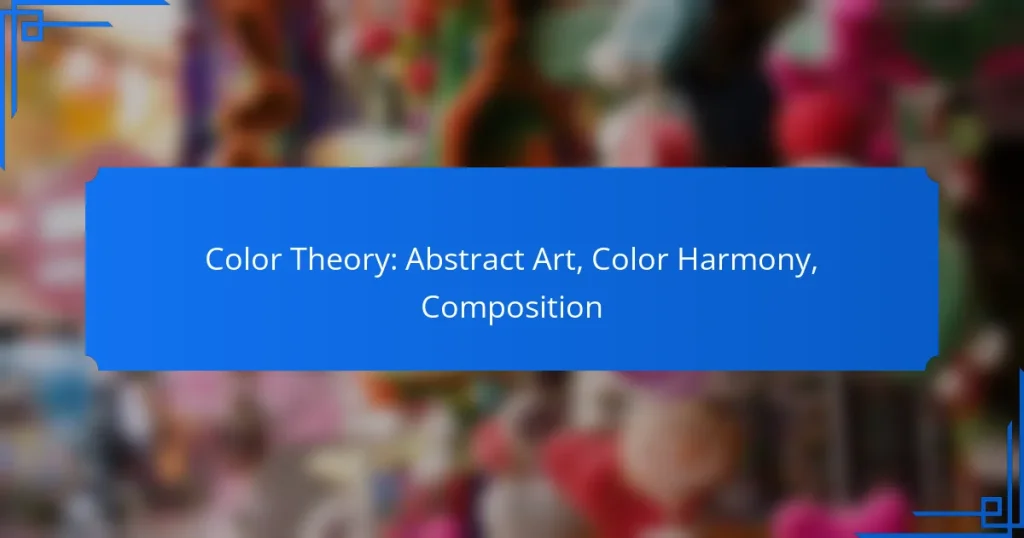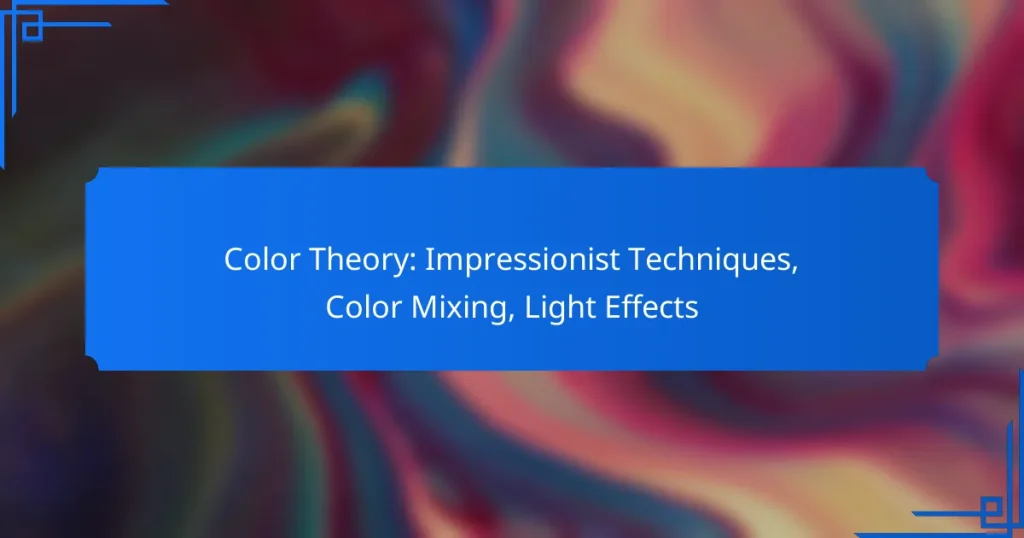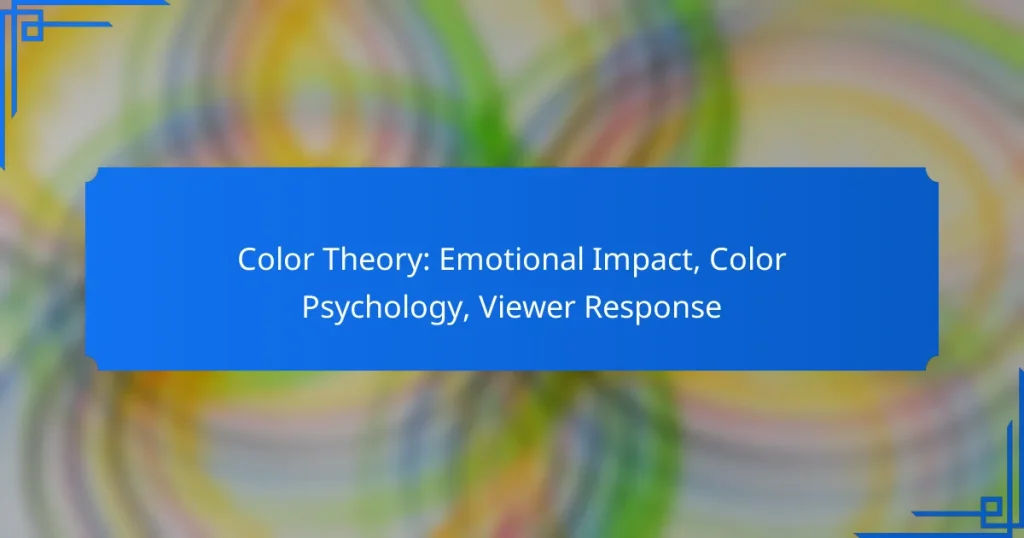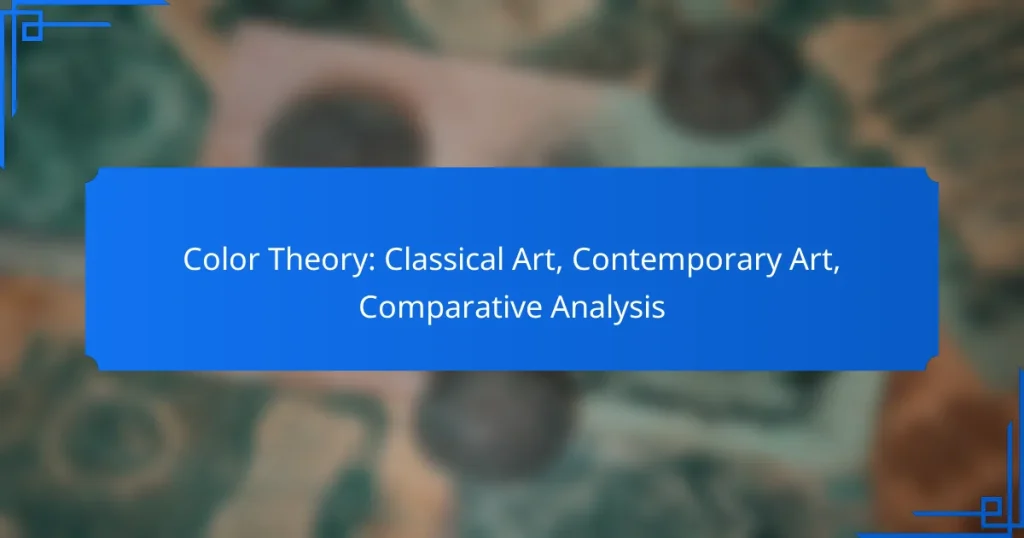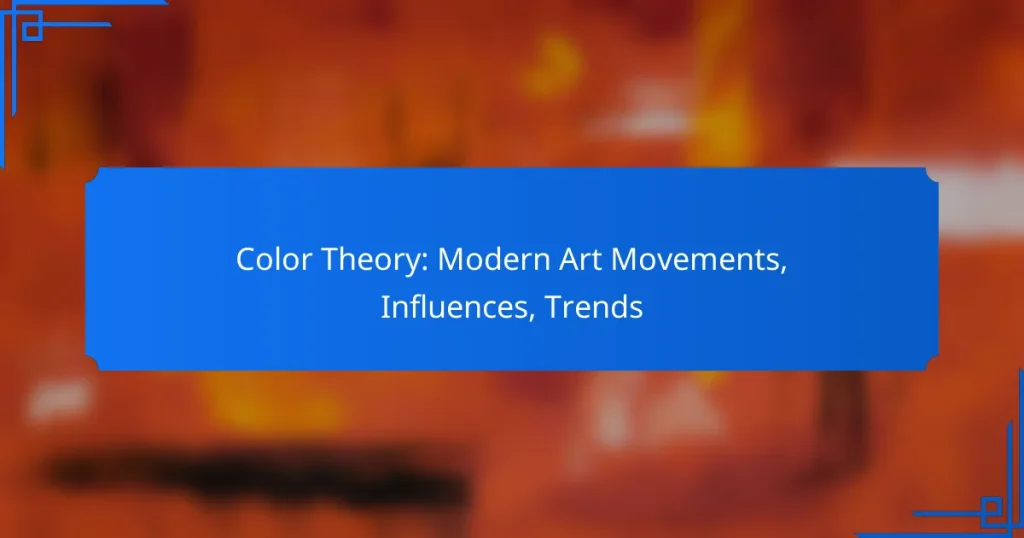Color theory plays a crucial role in the creation of art, guiding artists in their selection of colors to evoke emotions and achieve visual harmony. By understanding color relationships and key models like RGB, CMYK, and RYB, artists can make informed choices that enhance their work’s impact. Selecting a thoughtful color palette allows for the effective conveyance of mood and message in any artistic endeavor.
Color Theory: Fundamentals, Color Wheel, Color Relationships
Color Theory: Mixed Media, Techniques, Material Interactions
Color Theory: Impressionist Techniques, Color Mixing, Light Effects
Color Theory: Emotional Impact, Color Psychology, Viewer Response
Color Theory: Classical Art, Contemporary Art, Comparative Analysis
Color Theory: Modern Art Movements, Influences, Trends
How Does Color Theory Impact Art Creation?
Color theory significantly influences art creation by guiding artists in their use of colors to evoke emotions, create balance, and achieve harmony in their work. Understanding color relationships helps artists make informed choices that enhance the overall impact of their art.
Influences emotional responses
Colors have the power to evoke specific emotional responses in viewers. For instance, warm colors like red and orange can generate feelings of warmth and excitement, while cool colors such as blue and green often convey calmness and tranquility.
Artists can strategically use color to enhance the mood of their artwork. For example, a painting dominated by dark hues may evoke sadness or mystery, while bright, vibrant colors can inspire joy and energy. Understanding these associations allows artists to communicate their intended message more effectively.
Affects composition and balance
Color theory plays a crucial role in achieving composition and balance within an artwork. By using contrasting colors, artists can draw attention to focal points, while harmonious color schemes can create a sense of unity and flow.
When arranging colors, artists should consider the principles of color contrast and complementary colors. For instance, pairing a bright color with a neutral tone can create visual interest without overwhelming the viewer. This balance is essential for guiding the viewer’s eye throughout the piece.
Guides color harmony choices
Color harmony is vital for creating aesthetically pleasing artwork. Artists often rely on color wheel principles, such as analogous and complementary color schemes, to achieve this harmony. Analogous colors, which are next to each other on the color wheel, create a serene and cohesive look, while complementary colors, located opposite each other, provide striking contrast.
To ensure effective color harmony, artists should experiment with different combinations and consider the emotional impact of their choices. A simple approach is to limit the palette to three main colors, allowing for variations in shades and tints to maintain interest while ensuring cohesion.
What Are the Key Color Models in Art?
The key color models in art include RGB, CMYK, and RYB, each serving different purposes based on the medium used. Understanding these models helps artists choose the right colors for digital, print, or traditional painting applications.
RGB model for digital art
The RGB model, which stands for Red, Green, and Blue, is primarily used in digital art and design. It works by combining these three colors in varying intensities to create a broad spectrum of colors, with each color channel typically ranging from 0 to 255.
When working with RGB, artists should consider the display medium, as colors can appear differently on various screens. A common pitfall is assuming that colors will look the same in print as they do on-screen, so always check color profiles and calibrate displays when necessary.
CMYK model for print art
CMYK stands for Cyan, Magenta, Yellow, and Key (Black) and is the standard color model for print media. This model uses a subtractive color mixing process, where colors are created by subtracting varying percentages of light absorbed by the inks.
When designing for print, it’s crucial to convert RGB colors to CMYK to ensure accurate color reproduction. Artists should be aware that colors may appear duller in print than on screen, so testing prints before finalizing designs is advisable.
RYB model for traditional painting
The RYB model, which includes Red, Yellow, and Blue, is often used in traditional painting and art education. This model is based on the subtractive color mixing principle, where mixing these primary colors produces a range of secondary colors.
Artists using the RYB model should remember that the quality of pigments can affect the resulting colors. It’s beneficial to experiment with different brands and types of paints to understand how they mix and interact on canvas.
How to Choose a Color Palette for Your Artwork?
Choosing a color palette for your artwork involves selecting a harmonious set of colors that convey your intended message or emotion. Start by considering the mood you want to evoke and the visual impact you aim to achieve.
Use color wheel for guidance
The color wheel is a fundamental tool for artists, showcasing the relationships between colors. Utilize primary, secondary, and tertiary colors to create a balanced palette. For instance, complementary colors (those opposite each other on the wheel) can create striking contrasts, while analogous colors (those next to each other) offer a more harmonious look.
Experiment with different combinations on the color wheel to see which palettes resonate with your artistic vision. A simple approach is to select one dominant color and two accent colors to maintain focus and balance.
Consider color psychology
Color psychology plays a crucial role in how viewers perceive your artwork. Different colors evoke specific emotions; for example, blue often conveys calmness, while red can evoke passion or urgency. Understanding these associations can help you choose colors that align with the message of your piece.
When selecting your palette, think about the emotional response you want to elicit. For instance, if you’re creating a piece meant to inspire tranquility, consider using soft greens and blues, while vibrant yellows and oranges might be better for a lively, energetic feel.
Incorporate personal style
Your personal style should be a significant factor in choosing a color palette. Reflect on the colors you naturally gravitate toward in your previous works or those that resonate with your identity as an artist. This can help create a cohesive body of work that feels authentic.
To develop your unique palette, consider creating a mood board with colors and images that inspire you. This visual reference can guide your choices and ensure that your color selections align with your artistic voice.
What Are the Benefits of Understanding Color Theory?
Understanding color theory offers numerous advantages for artists, including enhanced creativity and improved communication through visual elements. By grasping how colors interact, artists can make informed choices that elevate their work and convey specific emotions or messages.
Enhances artistic expression
Color theory allows artists to express their ideas and emotions more effectively. By understanding the emotional impact of different colors, such as how warm tones evoke energy and cool tones promote calmness, artists can select palettes that resonate with their intended message.
Additionally, knowledge of color harmony—such as complementary and analogous color schemes—enables artists to create visually appealing compositions. This understanding can lead to more dynamic and engaging artwork that captures the viewer’s attention.
Improves visual communication
Effective visual communication relies heavily on color choices. Artists who understand color theory can convey complex ideas quickly and clearly through their work. For instance, using contrasting colors can highlight important elements, while a monochromatic scheme can create a sense of unity.
Moreover, color can influence perception and interpretation. Artists can manipulate color to guide the viewer’s eye, emphasize focal points, and evoke specific feelings, making their message more impactful.
Facilitates color mixing techniques
Mastering color theory simplifies the process of mixing colors. Artists who understand primary, secondary, and tertiary colors can create a broader palette by combining these hues effectively. This knowledge helps in achieving desired shades and tones without wasting materials.
For practical application, artists can use a color wheel as a reference for mixing. Knowing which colors complement or contrast can lead to more successful outcomes in painting and design projects, saving time and resources.
How Can Artists Apply Color Theory in Their Work?
Artists can effectively apply color theory by understanding how colors interact and influence emotions. By strategically using color combinations, they can enhance their artwork’s visual appeal and convey specific messages.
Experiment with complementary colors
Complementary colors are pairs of colors that, when combined, cancel each other out, creating a grayscale color. For example, red and green are complementary; using them together can create vibrant contrasts that draw attention. Artists should consider using these colors to highlight focal points in their work.
When experimenting, start with small areas to see how the colors interact. Be mindful of balance; too much contrast can overwhelm the viewer. Aim for a harmonious blend that still maintains visual interest.
Utilize analogous color schemes
Analogous colors are groups of three colors that are next to each other on the color wheel, such as blue, blue-green, and green. This scheme creates a serene and comfortable design, making it ideal for landscapes or portraits. Artists can use this approach to create depth and cohesion in their pieces.
To implement an analogous scheme, choose one dominant color and use the others as accents. This method can help in establishing a mood, whether it’s calmness or vibrancy. Keep in mind that varying the saturation and brightness of these colors can add complexity to the artwork.
Implement monochromatic designs
Monochromatic designs involve using variations of a single color, which can create a unified and sophisticated look. Artists can explore different shades, tints, and tones of a color to convey depth and dimension. This technique is particularly effective in minimalist art.
When working with monochromatic schemes, consider the emotional impact of the chosen color. For instance, blue can evoke calmness, while red can stimulate energy. Use contrasting values to create interest and avoid a flat appearance.
What Are Common Mistakes in Color Usage?
Common mistakes in color usage often stem from a lack of understanding of color theory and its principles. Artists may overlook the importance of color harmony, contrast, and the emotional impact of colors, leading to unbalanced or ineffective compositions.
Ignoring color harmony
Ignoring color harmony can result in artworks that feel chaotic or disjointed. Color harmony refers to the pleasing arrangement of colors that work well together, creating a sense of balance and unity. Artists should consider using color schemes such as complementary, analogous, or triadic to enhance visual appeal.
To achieve color harmony, start by selecting a dominant color and then choose supporting colors that complement or contrast effectively. For example, a blue-green dominant color can be paired with warm oranges for a vibrant effect. Using tools like color wheels can help identify harmonious combinations.
A common pitfall is using too many colors without a clear plan, which can overwhelm the viewer. Limit your palette to three to five colors to maintain focus and cohesion in your artwork.
